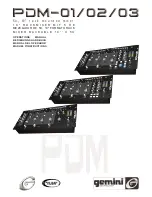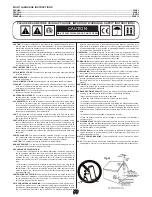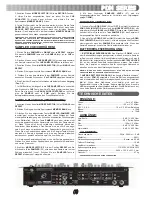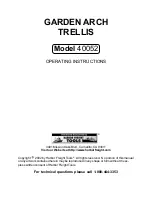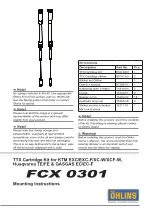
also plug a second & third
MIC
into the rear panel's
MIC 2
(20) &
MIC 3
(19)
1/4"
jacks. The decibel level of
MIC 2
(20) is controlled by the rotary
MIC 2 VOLUME CONTROL
(51). The decibel level of
MIC 3
(19) is con-
trolled by the
CH 1 SLIDE CONTROL
(39).
13.
TALKOVER:
The purpose of the
AUTO TALKOVER MODE
is to
allow the program playing to be attenuated so that the MIC may be
heard above the music. The
AUTO TALKOVER SWITCH
(54) controls
MIC 1
(49) and
MIC 2
(20) with
3
settings:
- When the
MIC/TALKOVER SWITCH
(54) is in the
BOTTOM
position,
MIC 1
(49),
MIC 2
(20) &
TALKOVER MODE
are all
OFF
.
- When the
MIC/TALKOVER SWITCH
(54) is in the
CENTER
position,
MIC 1
(49) &
MIC 2
(20) are
ON
&
TALKOVER MODE
is
OFF
. The
MIC
ON LED
indicator glows when
MIC 1
(49) &
MIC 2
(20) are
ON
.
- When the
MIC/TALKOVER SWITCH
(54) is in the
TOP
position,
MIC
1
(49) &
MIC 2
(20) are
ON
,
TALKOVER MODE
is
ON
, & the volume of
all sources except
MIC 1
(49) &
MIC 2
(20) are lowered automatically by
-16 dB
, when speaking into the
MIC
(s).
14.
BNC LAMP PORT:
The
BNC LAMP PORT
(22) connects a
12 V
BNC
goose neck lamp, such as the
Gemini GNL-700
to the
PDM
mixer.
The goose neck lamp will be powered by your mixer. To turn
ON
the
goose neck lamp, you must first attach the goose neck lamp to the
BNC
LAMP PORT
(22). Make sure the
PDM
mixer is
OFF
when connecting
the
12 V BNC
lamp. To connect the goose neck lamp, simply align the
screw cap of the goose neck lamp to the locking nodules of the
BNC
LAMP PORT
(22), push down, & twist the screw cap clockwise to lock
the
12 V BNC
goose neck lamp in place. Then turn
ON
your mixer. The
goose neck lamp should light-up. To detach the goose neck lamp from
the
BNC LAMP PORT
(22), first make sure your mixer is
OFF
. Turn
OFF
your mixer and the goose neck lamp will turn
OFF
. Unscrew the screw
cap by twisting it counterclockwise, then pull up & remove the goose
neck lamp.
15.
GROUND LIFT SWITCH:
The
GROUND LIFT SWITCH
(8) is used
to reduce background noise & hum when using multiple outlets to power
audio equipment. The switch should be in the position that provides the
least amount of noise or hum. If noise remains at the same level in both
positions, the
GROUND LIFT SWITCH
(8) should be kept in the
GND
position.
NOTE: MAKE SURE THE MIXER AND/OR AMPLIFIER IS OFF BEFORE SWITCHING THE
GROUND LIFT SWITCH TO PREVENT A TRANSIENT POP THAT MAY DAMAGE YOUR SYS-
TEM.
16.
VU METER:
The
VU METER
(23) indicates the decibel level of the
MASTER RCA
&
MASTER BALANCED
(3 & 6) outputs of the
LEFT
&
RIGHT
stereo levels.
ECHO SECTION:
An echo effect may be applied to the
PGM
, or
MIC 1
(49) &
MIC 2
(20)
signals by switching the
ECHO ASSIGN
(55) switch from
MIC 1-2
on the
LEFT
, to
OFF
in the
MIDDLE
, to
MASTER
on the
RIGHT
& vice versa.
When using
ECHO
(55), you may adjust the effect of the
ECHO
(55) by
using the rotary
REPEAT
(56),
DELAY
(57), and
ECHO VOLUME
(58)
controls. To turn the
ECHO ASSIGN
(55)
OFF
or lower the
ECHO VOL-
UME
(58).
SOUND EFFECTS SECTION:
Six different sound effects (
APPLAUSE
,
SCREAM
,
COPTER
,
SCRATCH
,
H
2
O
&
GLASS
) may be added to your mix by pressing the
SOUND EFFECTS CONTROL BUTTONS
(61). The volume of the
effects can be adjusted using the rotary
EFX VOLUME
(60) located
above the
APPLAUSE
effect button. The pitch of the effects can be
increased or decreased using the rotary
SPEED CONTROL
(59) locat-
ed above the
SCRATCH
effect button.
MEMORY INFORMATION:
The
PDM-03
is equipped with
5 MEMORY BANKS
(59). The two banks
marked
8
&
8
are
8
seconds in length, the two banks marked
16
&
16
are
16
seconds in length and the bank marked
48
is
48
seconds in
length. These banks are separate &
CANNOT
be linked. You can store
a different sample in each bank, but they must be recorded individually
& must be played one at a time.
(7
7)
ASSIGN
switch allows you to direct
CH 1
,
2
,
3
, or
4
through the
LEFT
side of the
CROSS FADER
(36). The
RIGHT ASSIGN
(35) switch allows
you to direct
CH 1
,
2
,
3
, or
4
through the
RIGHT
side of the
CROSS
FADER
(36). When the
ASSIGN SWITCH
(es) (34, 35) are at
OFF
, you
will not have a
CH
assigned to the
CROSS FADER
(36). This allows you
to control the
PGM
with the use of the respective
CH SLIDE CON-
TROLS
, thus layering the
PGM
with up to four
CH
s.
8.
CROSS FADER SECTION:
The
CROSS FADER
(36) allows you to
mix from one source to another. The
PDM
mixers feature an assignable
CROSS FADER
(36). The rotary controlled
ASSIGN SWITCHES
(34,
35) allow you to select which channel will play through each side of the
CROSS FADER
(36). The
CROSS FADER
(36) in your unit is remov-
able & if the need arises can be easily replaced. Your Gemini mixer
comes with a
RG- 45
(
RAILGLIDE™
)
DUAL-RAIL CROSS FADER
.
RAIL GLIDE™ CROSS FADERS
have internal dual stainless steel rails
that allow the slider to ride smoothly and accurately from end to end.
Also available is our
RG-45 PRO
(
PROGLIDE™
)
CROSS FADER
with
a special curve designed for scratch mixing. Just purchase one from
your
Gemini
dealer & follow the instructions:
NOTE: DO NOT APPLY PRESSURE WHILE USING THE CROSSFADER. LIGHTLY GLIDE
THE CROSSFADER BACK AND FORTH. PRESSING DOWN ON THE CONTROLS CAN
BEND CONTACTS AND CAUSE A LOSS OF SOUND.
9.
EQUALIZER (EQ):
These units feature dual
10 BAND GRAPHIC
EQUALIZERS
(32, 33) that will allow you to adjust the sound to fit any
room. By adjusting any of the
10 EQ SLIDE CONTROLS
(32, 33), you
can cut or boost the tonal characteristics of the sound coming from
PGM
to the speaker(s) by
±12 dB
. To activate the dual
10 BAND GRAPHIC
EQ
, switch the
EQ SWITCH
(31) to
ON
, & the
EQ LED
will light up to
indicate that the
EQ
has been engaged. To deactivate the dual 10 band
graphic
EQ
, switch the
EQ SWITCH
(31) to
OFF
, & the
EQ LED
will turn
OFF
. When activated, the
EQ
(32, 33) controls the
LEFT
and
RIGHT
side of your stereo speakers. The
PGM
&
EQ
are controlled by the
MAS-
TER VOLUME
(27). To balance the sound of the
PGM
playing through
the
MASTER VOLUME
(27) on the
LEFT
&
RIGHT
side of your speak-
ers you must mirror the
EQ
levels on the
LEFT
(32) &
RIGHT
(33)
EQ
controls.
NOTE: FOR OPTIMAL PERFORMANCE IN YOUR SOUND OUTPUT, HAVE YOUR SOUND
SET TO STEREO NOT MONO. START WITH THE EQ LEVELS (32, 33) AT CENTER VALUE.
THE EQ SLIDE CONTROLS (32, 33) SHOULD LOCK AT THIS POSITION. ADJUST YOUR
MASTER VOLUME (27) CONTROL FROM MID TO LOW VOLUME RANGE. THEN ADJUST
THE LEFT (32) OR RIGHT (33) EQ, ONE SLIDE CONTROL AT A TIME, TO A COMFORT
ABLE LEVEL. ONCE YOU ARE SATISFIED WITH THE SOUND OF ONE SIDE, MATCH THE
EQ SETTINGS ON THE OTHER SIDE. ONCE YOU HAVE PASSED THE CENTER VALUE ON
THE EQ (32, 33), THE MASTER OUTPUT, AS INDICATED IN THE VU METER (23), MAY
EXPERIENCE A TONAL BOOST. PLEASE ADJUST THE MASTER VOLUME (27) TO A COM-
FORTABLE LEVEL SO YOU DO NOT OVERLOAD YOUR SYSTEM. CLIPPING WILL OCCUR
WHEN YOU ARE OVERLOADING YOUR SYSTEM. LOWER THE MASTER VOLUME (27) OR
ADJUST YOUR EQ (32, 33) SETTINGS SO THAT CLIPPING DOES NOT OCCUR. THEN YOU
MAY RAISE THE MASTER VOLUME (27) TO A LEVEL WITH WHICH YOU ARE COMFORT-
ABLE.
10.
STEREO/MONO:
You can convert your sound output from
STEREO
to
MONO
& vice versa by using the
STEREO/MONO SWITCH
(30).
Switch to the
LEFT
to convert to
STEREO
. Switch
RIGHT
to convert to
MONO
.
11.
OUTPUT SELECTION CONTROL:
Once you are comfortable with
the sound level of your music you may adjust the decibel level of the
PGM
with the
MASTER VOLUME
(27) control.
MASTER RCA
&
BAL-
ANCED MASTER OUTPUTS
(3, 6) are controlled by the level of the
MASTER VOLUME
(27) control. You may adjust the volume of the
ZONE
(5) output with the
ZONE
(29) rotary control. You may adjust the
volume of the
BOOTH
(7) output with the
BOOTH
(28) rotary control.
The volume of your
RECORD
(4) output is controlled strictly by the
CH
SLIDE CONTROLS
.
12.
MIC SECTION:
Plug your main
MIC
into the
MIC 1
combination
XLR-1/4"
input (49) located on the face panel. The rotary controls for
HIGH
(52) and
LOW
(53) allow you to adjust the tone of
MIC 1
(49). The
rotary
MIC 1 VOLUME CONTROL
(50), above the rotary
MIC 2 VOL-
UME CONTROL
(51), adjusts the decibel level of
MIC 1
(49). You may
P
PD
DM
M
S
SE
ER
RIIE
ES
S
P
PD
DM
M
S
SE
ER
RIIE
ES
S
REPLACEABLE CROSS FADER
1. UNSCREW THE OUTSIDE
FADER PLATE SCREWS (B).
- DO NOT TOUCH INSIDE
SCREWS (C).
2. CAREFULLY REMOVE OLD
CROSS FADER AND UNPLUG
CABLE (D).
3. PLUG IN THE NEW CROSS
FADER INTO CABLE (D) AND
PLACE BACK INTO MIXER.
4. SCREW THE CROSS FADER
TO MIXER WITH THE FADER
PLATE SCREWS (B).
PDM-02 ECHO/EFX:
PDM-03 SAMPLER OPERATION:
Summary of Contents for PDM-01
Page 3: ... 3 PDM 0 01 Front REAR ...
Page 4: ... 4 4 PDM 0 02 Front REAR ...
Page 5: ... 5 ...
Page 19: ... 19 NOTES P PD DM M S SE ER RIIE ES S P PD DM M S SE ER RIIE ES S ...

